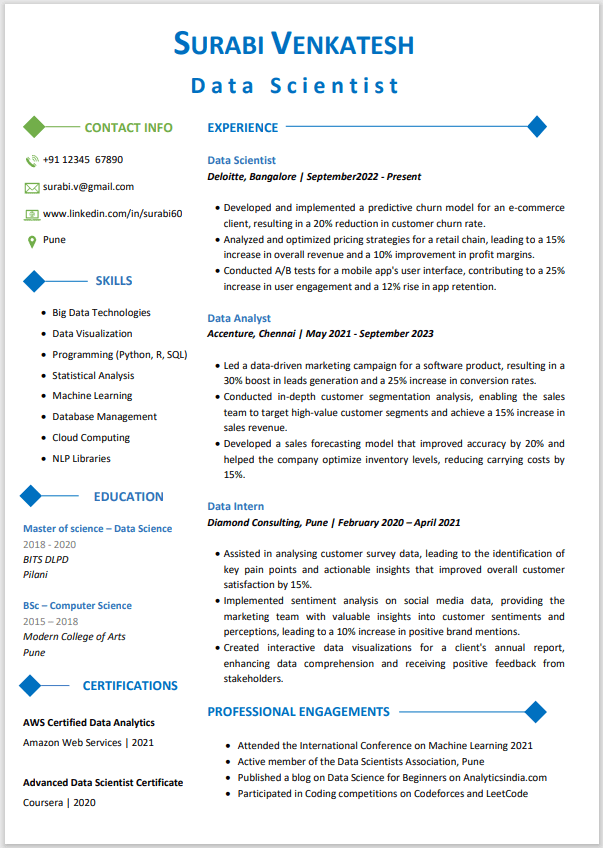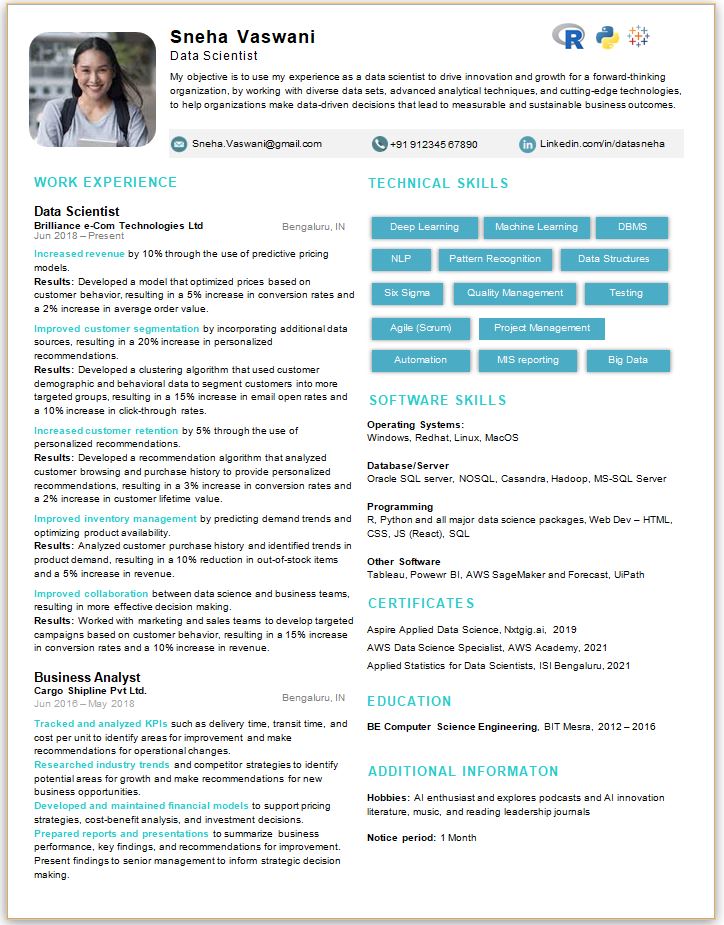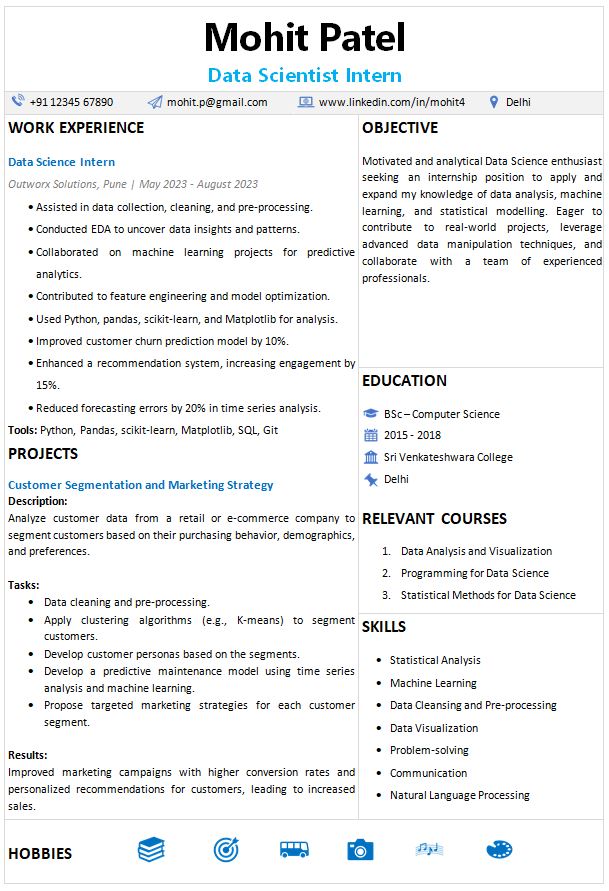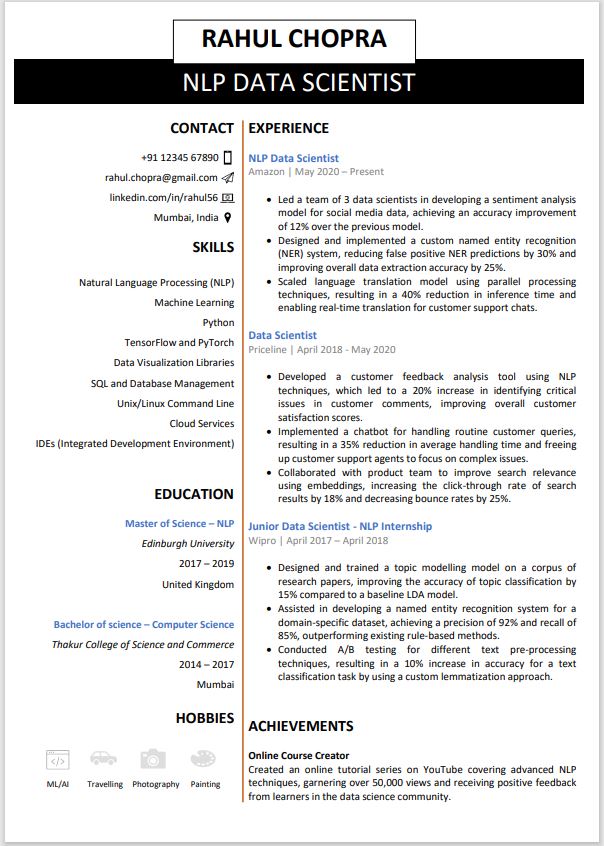Classic Resume
Data Scientist Sample Resume
Data Scientist
Dsci


Objective
Here are two more options if you want to keep your career objective statement slightly more generic.
Objective 1:
Dedicated data scientist with a proven track record of leveraging data-driven insights to solve complex business challenges. Seeking a role where I can apply my expertise in statistical analysis, machine learning, and data visualization to uncover valuable patterns, drive informed decision-making, and contribute to the advancement of data-driven strategies within a dynamic organization.
Objective 2:
Passionate data scientist with a strong foundation in data manipulation, modeling, and predictive analytics. Eager to join a forward-thinking team where I can utilize my skills to extract actionable insights from diverse datasets, develop innovative machine learning models, and collaborate with cross-functional stakeholders to enhance business processes and drive competitive advantage.
Education
BE Computer Science, Engineering Graduates, Math Graduates
Skills
You should be strategic about which skills to include on your resume. Quite simply, pick the skills that you possess and that are referenced on the job description.
Here are ten skills (5 technical and 5 soft skills) that are essential to list on a data scientist's resume. Technical Skills:
Programming Languages (e.g., Python, R):
Proficiency in programming languages enables data scientists to manipulate data, build models, and implement algorithms, forming the foundation of their analytical work.
Machine Learning:
Mastery of machine learning techniques such as regression, classification, clustering, and deep learning is crucial for creating predictive models and deriving insights from data.
Data Manipulation and Analysis (e.g., Pandas, NumPy, SQL):
Data manipulation skills allow data scientists to clean, preprocess, and analyze data effectively, ensuring data quality and reliability.
Data Visualization (e.g., Matplotlib, Seaborn, Tableau):
Data visualization skills help in conveying complex insights and patterns to non-technical stakeholders, aiding in informed decision-making.
Big Data Tools (e.g., Hadoop, Spark):
Proficiency in big data tools is essential for handling and analyzing large datasets efficiently, enabling data scientists to work with diverse data sources.
Soft Skills:
Problem-Solving:
Data scientists need strong problem-solving skills to define research questions, design analytical approaches, and develop solutions to complex data challenges.
Critical Thinking:
Critical thinking allows data scientists to evaluate models, methodologies, and results rigorously, ensuring the validity and reliability of their analyses.
Effective Communication:
Data scientists must convey their findings, methodologies, and insights to both technical and non-technical audiences, facilitating collaboration and informed decision-making.
Collaboration:
Collaborative skills are essential for working with cross-functional teams, including engineers, business analysts, and domain experts, to drive data-driven initiatives.
Adaptability:
Given the rapidly evolving field of data science, the ability to adapt to new tools, technologies, and methodologies is crucial for staying effective and relevant in the industry.
Each of these skills plays a distinct role in a data scientist's role and contributes to their ability to extract valuable insights from data, drive data-driven strategies, and communicate findings effectively. Listing these skills on a resume demonstrates a comprehensive skill set and the potential to excel in a data science role.
Projects
Here are a few more examples of how to list work experience on your Data science resume.
Employment 1: Data Scientist at Infy Tech Solutions, Bangalore.
- Developed and deployed a recommendation engine using collaborative filtering, boosting user engagement by 20% and contributing to a $2 million increase in annual revenue.
- Led a cross-functional team to design and implement a fraud detection model, reducing fraudulent transactions by 15% and resulting in a cost savings of $500,000.
- Conducted A/B tests on pricing strategies, optimizing product pricing and leading to a 10% increase in conversion rates, generating an additional $1.5 million in sales.
Interests/Hobbies
You should also be strategic about which hobbies and interests you want to highlight on your resume as carefully chosen hobbies help immediately demonstrate to the potential employer you are passionate about your field and that you would be much more than a salaried employee. Including technical hobbies on a data scientist's resume is crucial for several reasons:
Demonstrates Passion: Technical hobbies showcase your genuine enthusiasm for data science and problem-solving, helping employers see your commitment beyond your formal work hours.
Reinforces Skills: These hobbies reinforce the skills listed on your resume, providing tangible evidence of your abilities and demonstrating your hands-on experience.
Sets You Apart: In today's competitive job market, technical hobbies differentiate you from other candidates by highlighting your proactive engagement and dedication to continuous learning.
Practical Application: Technical hobbies allow you to apply your skills to real-world scenarios, enhancing your problem-solving capabilities and preparing you for diverse challenges.
Conversation Starters: Interviewers often inquire about hobbies during interviews. Technical hobbies provide unique talking points that can help you connect with interviewers on a deeper level and showcase your technical prowess.
Incorporating these hobbies on your resume not only portrays a strong technical image but also reflects your dedication to excellence and growth in the competitive landscape of data science.
1. Kaggle Competitions: Participation in Kaggle data science competitions showcases your commitment to solving complex technical challenges and continuously improving your analytical skills.
2. Algorithmic Puzzles: Engaging in algorithmic puzzles and coding challenges outside of work demonstrates your enthusiasm for technical problem-solving and algorithm optimization.
3. Open-Source Contributions: Contributing to open-source data science projects highlights your dedication to collaborative problem-solving and your ability to contribute to the broader community.
4. Data Visualization Projects: Creating personal data visualization projects exhibits your knack for translating complex data into visually informative insights, showcasing both creativity and technical acumen.
5. Machine Learning Side Projects: Developing machine learning models for personal projects illustrates your eagerness to apply technical skills to real-world problems beyond your professional responsibilities.
6. Programming Forums: Active participation in programming and data science forums signals your commitment to sharing knowledge, problem-solving, and staying engaged with the community.
7. Online Courses and Tutorials: Enrolling in and completing technical courses and tutorials outside of your formal education demonstrates your proactive pursuit of advanced technical skills and knowledge.
8. Hackathons: Taking part in hackathons, especially those focused on data science, reflects your dedication to intense technical problem-solving within a competitive environment.
9. Coding Meetups: Attending coding and data science meetups shows your interest in staying connected with fellow professionals and discussing technical challenges and solutions.
10. Technical Blogs: Writing technical blog posts about data science concepts, challenges, and solutions indicates your ability to articulate complex technical topics and share your insights with others.
Experience
Employment 2: Data Scientist Intern at Tiger Analytics
- Created a data visualization dashboard using Tableau, facilitating data-driven decision-making for marketing campaigns and improving campaign ROI by 25%.
- Collaborated with the research team to develop a machine learning model for sentiment analysis, enhancing accuracy by 15% and enabling more informed brand perception analysis.
- Automated data preprocessing tasks using Python scripts, reducing data preparation time by 40% and enabling analysts to focus on higher-level insights.
Importance of Listing Work Achievements:
Listing work achievements in a concise format like this is crucial for several reasons:
Immediate Impact:
Hiring managers often skim resumes, and succinct achievements catch their attention quickly, increasing the chances of your resume being thoroughly reviewed.
Quantified Results:
By quantifying the impact of your work, you demonstrate your value to potential employers in a tangible and impressive manner.
Relevance:
Focusing on achievements directly related to the job you're applying for highlights your ability to contribute positively to the company's goals.
Efficiency:
A concise format saves space on your resume while conveying key accomplishments effectively, leaving room for other important information.
Storytelling:
Each achievement tells a mini-story of your contributions, skills, and impact, creating a compelling narrative of your career journey.
Memorability:
Short, impactful statements are more likely to be remembered by hiring managers, making your resume stand out among others.
Additional Inputs
If you are either a student still in college or someone recently graduate or someone with some work experience but want to enter the field of data science, you may want to consider working on projects that would help demonstrate to potential employers that you possess the skills that would make you a successful data scientist.
Here are two project ideas and how to go about pursuing them.
Project Idea 1: Predictive Customer Churn Analysis
Description:
Build a predictive model to identify customers at risk of churning (canceling their subscription or service). Use historical customer data, including usage patterns, demographics, and interactions, to create a machine learning model that predicts churn probabilities.
Implementation Steps:
Data Collection: Gather historical customer data, including features like usage frequency, tenure, billing history, and interactions.
Data Preprocessing: Clean and preprocess the data, handling missing values and converting categorical variables into a suitable format.
Feature Engineering: Select relevant features and engineer new ones that might contribute to predicting churn, such as customer engagement metrics.
Model Selection: Choose appropriate machine learning algorithms (e.g., logistic regression, random forest, XGBoost) for building the predictive model.
Model Training and Evaluation: Split the data into training and testing sets, train the model, and evaluate its performance using metrics like accuracy, precision, recall, and F1-score.
Hyperparameter Tuning: Fine-tune the model's hyperparameters to optimize its predictive performance.
Model Interpretation: Use techniques like feature importance analysis to understand which factors contribute most to customer churn predictions.
Deployment and Visualization: Create a simple user interface or interactive dashboard to showcase the model's predictions and insights.
Project Idea 2: Sentiment Analysis for Social Media Posts
Description: Develop a sentiment analysis model to determine the sentiment (positive, negative, neutral) of social media posts. This project involves natural language processing and text classification.
Implementation Steps:
Data Collection: Collect a labeled dataset of social media posts along with their corresponding sentiments.
Text Preprocessing: Clean and preprocess the text data by removing stopwords, punctuation, and converting text to lowercase.
Feature Extraction: Convert text data into numerical features using techniques like TF-IDF (Term Frequency-Inverse Document Frequency) or word embeddings.
Model Selection: Choose a text classification algorithm (e.g., Naive Bayes, Support Vector Machines, neural networks) for sentiment analysis.
Model Training and Evaluation: Split the dataset into training and testing sets, train the model, and evaluate its performance using accuracy, precision, recall, and F1-score.
Fine-Tuning and Validation: Experiment with different preprocessing techniques, feature extraction methods, and model architectures to improve performance.
Visualization: Visualize the sentiment distribution of social media posts and showcase the model's predictions through word clouds or interactive graphs.
Interpretation: Analyze the most indicative words or phrases for each sentiment class using techniques like word importance or sentiment lexicons.
Completing these projects will not only enhance your technical capabilities in data science but also provide tangible evidence of your skills to potential employers. Make sure to document your process, code, and results, and consider creating a portfolio or personal website to showcase your projects to employers.
Why this template works
This is a simple resume template that does not interfere with the presentation of the content of a technical resume.
Simple resume templates work best for technical domains for several reasons:
Clarity: Technical roles often require conveying complex information succinctly. Simple templates emphasize content over design, making it easier for recruiters and hiring managers to focus on your skills and achievements.
Readability: Elaborate designs can distract from the content. A simple template with clean typography and organized sections ensures that your resume is easy to read and understand.
Emphasis on Content: In technical domains, the content of your resume is of paramount importance. A simple template allows you to showcase your technical skills, projects, and accomplishments without distractions.


